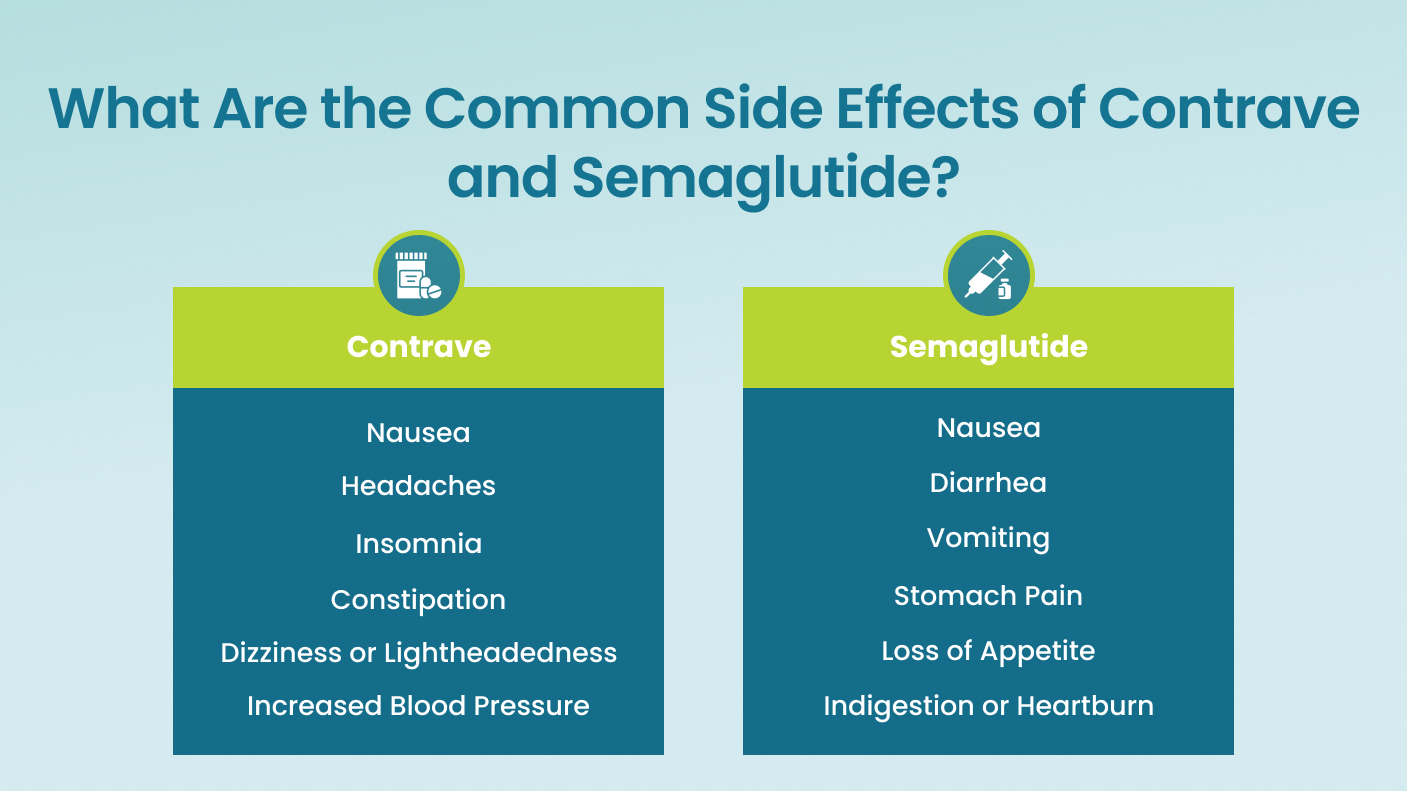
Contrave vs Semaglutide for Weight Loss
obesity. Research shows that individuals with simple obesity face significant challenges in achieving meaningful weight loss, with only about 1 in 12 men and 1 in 10 women managing a 5% reduction in body weight annually.
It is very difficult to lose weight through lifestyle changes. Medical interventions, including prescription medications, are increasingly essential for managing these conditions effectively. Contrave and Semaglutide are two medications that approach weight loss through different mechanisms but share the goal of helping people achieve a healthier weight.
This blog will discuss the details of Contrave vs Semaglutide, comparing their effectiveness, side effects, ideal candidates, and costs so you can determine which option might be the best fit for your weight loss journey.
What is Contrave?
Contrave is an FDA-approved prescription medication aiding weight management in adults who are obese or overweight and have weight-related medical conditions. It combines two active ingredients, bupropion, and naltrexone, each of which plays a unique role in supporting weight loss.
How Does Contrave Work?
Contrave targets the brain’s reward system and appetite control centers to help regulate cravings and reduce food intake. Here’s how its components contribute:
Bupropion: Originally developed as an antidepressant and smoking cessation aid, bupropion influences dopamine and norepinephrine levels in the brain. Modifying the brain’s reward pathways helps reduce food cravings and emotional eating.
Naltrexone: Commonly used to manage alcohol and opioid dependency, naltrexone works by blocking opioid receptors, reducing cravings, and reinforcing healthier eating behaviors.
Together, these ingredients create a dual-action approach to appetite suppression and behavior modification, making it easier for individuals to stick to calorie-restricted diets and lifestyle changes.
How Long Does It Take for Contrave to Work?
Contrave’s effects on weight loss can vary. Most individuals notice a reduction in appetite and cravings within a few weeks of starting the medication. Studies suggest significant weight loss typically occurs after 16 weeks when paired with consistent dietary and lifestyle changes.
Contrave is not a GLP-1 receptor agonist, like Semaglutide, but it addresses weight management through its unique brain-targeting mechanism. Understanding its benefits and limitations is crucial for choosing the right weight loss approach.
What is Semaglutide?
Semaglutide is a prescription medication primarily used for managing type 2 diabetes and chronic weight management. It belongs to a class of drugs known as GLP-1 receptor agonists (glucagon-like peptide-1), which mimic the effects of a natural hormone in regulating blood sugar and appetite.
How Does Semaglutide Work?
Semaglutide mimics the actions of GLP-1, a hormone released in the gut in response to eating. It influences weight loss and blood sugar control through multiple mechanisms:
Appetite Regulation: Semaglutide interacts with receptors in the brain’s appetite control center, promoting feelings of fullness and reducing hunger.
Delayed Gastric Emptying: It slows the rate at which food leaves the stomach, helping individuals feel satisfied for longer periods.
Blood Sugar Control: It helps regulate blood sugar levels by stimulating insulin release and suppressing glucagon, particularly in those with type 2 diabetes.
These combined effects make Semaglutide a powerful option for diabetes management and weight loss.
How Long Does It Take for Semaglutide to Work?
Semaglutide’s weight loss effects typically become noticeable within 12 weeks of consistent use. Maximum results often occur after several months, especially when combined with a calorie-restricted diet and regular physical activity.
Unlike Contrave, Semaglutide works at the hormonal level to increase satiety and improve metabolic health. Its dual utility in diabetes control and weight loss makes it a versatile choice for those looking to manage both conditions effectively.
What’s the Main Difference Between Contrave and Semaglutide for Weight Loss?
The main difference between Contrave and Semaglutide lies in their mechanism of action:
- Contrave combines bupropion and naltrexone to reduce cravings and emotional eating by targeting the brain’s reward system.
- Semaglutide, a GLP-1 receptor agonist, promotes satiety and appetite control by mimicking a natural hormone, leading to weight loss.
Contrave vs Semaglutide: Essential Differences
| Feature | Contrave | Semaglutide |
| Primary Use | Weight loss by controlling cravings and emotional eating | Weight loss and blood sugar control, also used for type 2 diabetes |
| Average Weight Loss | 5% of body weight with lifestyle changes | 15–20% of body weight with lifestyle changes |
| FDA-Approved For | Obesity management and weight loss | Type 2 diabetes (Ozempic), weight loss (Wegovy) |
| Delivery Method | Oral tablets | Oral tablets or Injection (subcutaneous) |
| Time for Noticeable Effects | 16 weeks | 12 weeks |
| Target Population | Individuals struggling with cravings and emotional eating | Individuals seeking significant weight loss, especially those with type 2 diabetes |
| Long-Term Impact for Weight Loss | Moderate | High |
Contrave vs Semaglutide: Effectiveness for Weight Loss
Both contrave and semaglutide have been evaluated in large clinical trials, demonstrating significant results in reducing body weight. However, they have key differences in their work and overall effectiveness.
Clinical Efficacy
Contrave
In clinical trials, Contrave has demonstrated moderate effectiveness for weight loss, with participants achieving an average of 5-10% weight reduction from baseline. The COR-I and COR-II studies, which included a range of overweight and obese individuals, showed significant decreases in body weight, with those on Contrave experiencing greater weight loss compared to placebo. However, the effect was less pronounced than other weight loss treatments.
Safety Profile: The most common side effects of Contrave include nausea, headache, constipation, and dizziness. It is contraindicated in individuals with a history of seizures or eating disorders due to its bupropion component.
Semaglutide
The STEP program, which includes several trials like STEP 1, STEP 2, and STEP 3, consistently showed more significant weight loss with semaglutide 2.4 mg compared to placebo. In STEP 1, for example, participants lost 14.9% of their body weight on average with semaglutide, compared to just 2.4% with placebo. Similar results were seen across other trials, with semaglutide patients more likely to achieve significant weight loss milestones (e.g., ≥5% and ≥10% weight loss) than those taking a placebo.
Safety Profile: Common side effects of semaglutide include nausea, diarrhea, and constipation. It is generally well-tolerated, though it can cause gastrointestinal issues, especially in the early stages of treatment.
Long-Term Results
- Contrave is effective in the short-to-medium term, with patients maintaining some weight loss through continued medication use. However, after discontinuation, many patients experience some weight regain.
- Semaglutide has shown sustained effectiveness, with patients maintaining significant weight loss even after one year of treatment in trials. The STEP 5 trial, which lasted two years, demonstrated a continued reduction in weight with semaglutide, with participants achieving 15.2% weight loss compared to just 2.6% for the placebo group.
Which is More Effective?
Semaglutide emerges as the more practical option for weight loss, showing higher and more sustained reductions in body weight compared to Contrave. Clinical trials consistently demonstrate that semaglutide leads to significant weight loss and higher proportions of patients achieving weight loss milestones.
Contrave can still be a viable option for some individuals, especially those who may not tolerate GLP-1 medications or prefer a medication targeting hunger and cravings. However, semaglutide has the edge regarding overall efficacy for most individuals seeking substantial weight loss.
What Are the Common Side Effects of Contrave and Semaglutide?

Contrave and Semaglutide have potential side effects, though they differ in nature and severity. It’s essential to be aware of these to decide which treatment is right for you.
Common Side Effects of Contrave
Contrave combines two medications, bupropion and naltrexone, which can cause the following side effects:
Nausea: Some users may experience mild to moderate nausea, especially when starting the medication.
Headaches: Tension or migraines are a reported side effect in some people.
Insomnia: Difficulty sleeping or staying asleep can occur, often due to the stimulant-like effect of bupropion.
Constipation: Some individuals may experience digestive issues, particularly constipation.
Dizziness or Lightheadedness: Due to changes in appetite and eating patterns.
Increased Blood Pressure: As bupropion can raise blood pressure, monitoring is recommended, especially in those with pre-existing hypertension.
Common Side Effects of Semaglutide
Semaglutide, a GLP-1 receptor agonist, has its own set of potential side effects.
Nausea: A common issue, particularly when starting the medication. It may subside as the body adjusts.
Diarrhea: Some people may experience digestive disturbances such as diarrhea or loose stools.
Vomiting: This can occur in the initial stages of treatment, especially as the body adapts.
Stomach Pain: Some users report abdominal discomfort, bloating, or cramps.
Loss of Appetite: While this is part of the intended effect, it can be severe for some individuals.
Indigestion or Heartburn: Some people experience mild acid reflux or indigestion.
While these side effects are generally temporary and subside as your body adjusts to the medication, it’s essential to consult a healthcare provider if symptoms persist or worsen. Both medicines should be used under medical supervision to monitor for adverse effects or complications.
Including Contrave or Semaglutide in Your Weight Loss Plan
When considering Contrave or semaglutide for weight loss, integrating these medications into your daily routine can help maximize their effectiveness. However, following a structured approach that includes lifestyle modifications, dietary changes, and regular check-ins with your healthcare provider is essential.
For Contrave
Starting the Medication
Contrave is typically started with a gradual dose increase to minimize side effects. You’ll begin with a lower dose, slowly increasing over several weeks. This approach helps your body adjust and reduces the risk of side effects like nausea and headaches.
It is usually taken twice a day—once in the morning and once in the evening. It can be taken with or without food, but consistency in timing is key.
Tracking Your Progress
As with any weight loss medication, tracking your weight, diet, and any side effects is important. Many people find it helpful to keep a food diary or use an app to log their meals and snacks.
Monitor your weight regularly and track any changes in appetite or cravings, as Contrave helps regulate both.
Lifestyle Adjustments
For Contrave to be most effective, it should be combined with a calorie-controlled diet and increased physical activity. A balanced diet with proper portion control will help you achieve better results. Regular exercise (at least 30 minutes of moderate activity most days of the week) can enhance Contrave’s effects on weight loss.
Consider working with a dietitian to ensure you get the necessary nutrients while creating a calorie deficit for weight loss.
Stay Consistent
Adherence to the prescribed dose and consistency in taking the medication is essential. Missing doses or stopping the medication prematurely can reduce its effectiveness. If you experience any side effects, speak to your healthcare provider. They may adjust your dosage or offer tips for managing discomfort.
For Semaglutide
Starting the Medication
Semaglutide is typically initiated at a low dose, gradually increased over several weeks to reduce side effects like nausea. Starting at a low dose also allows the body to adjust to the medication’s effects on appetite and digestion.
Semaglutide is administered as a weekly subcutaneous injection. You’ll typically inject it once a week on the same day each week, with or without food. Be sure to rotate the injection site to avoid irritation.
Incorporating Into Your Routine
Since semaglutide is a weekly injection, you can easily incorporate it into your routine by setting a reminder on your phone or calendar. Many people find it helpful to tie it to another regular activity, such as injecting it on the same day each week when they do their grocery shopping or another regular event.
Diet and Exercise
Like Contrave, semaglutide requires a healthy diet and regular exercise to work effectively. The medication helps reduce appetite, so sticking to a calorie-controlled diet may be more manageable.
Focus on whole, nutrient-dense foods, including plenty of vegetables, lean proteins, and whole grains. Avoid processed foods high in sugar or fat, which can undermine weight loss efforts.
Regular exercise can help maintain muscle mass during weight loss and boost metabolism. Aim for a combination of aerobic (cardio) exercises and strength training.
Monitor Your Progress
Track your weight loss progress, changes in appetite, and any side effects. Keeping a log will help you and your healthcare provider make informed decisions about adjusting treatment or other lifestyle changes.
Talk to your healthcare provider if you experience gastrointestinal side effects such as nausea, vomiting, or diarrhea. These side effects often subside after a few weeks as your body adjusts to semaglutide.
Frequently Asked Questions
Can Contrave and Semaglutide be used together?
While Contrave and Semaglutide help in weight loss, they work through different mechanisms, and using them together should only be done under the guidance of a healthcare provider. Your healthcare provider will assess your specific needs and determine the best course of treatment, considering potential interactions and individual health factors.
Does Contrave cause hair loss?
Hair loss is not a common side effect of Contrave. However, like all medications, Contrave can cause different side effects in some individuals. Common side effects may include nausea, constipation, headaches, and dizziness, but hair loss is not typically one of them. Suppose you experience any unusual side effects, including hair thinning. In that case, you must contact your healthcare provider to discuss your symptoms and determine whether the medication fits you.
Take the Next Step in Your Weight Loss Journey with IV Drips
At IV Drips, we’re dedicated to helping you optimize your health and wellness through personalized treatments. Our professional medical team will collaborate with you to create a tailored plan that meets your unique hydration and nutrient needs, ensuring you feel your best every day.
Choose your wellness therapy option:
- Semaglutide Injections: Get expert-administered injections to support your weight loss journey.
- Convenient In-Clinic or At-Home Options: With self-administered options, you can receive your treatments at our clinic or in the comfort of your own home.
- Hydration & Vitamin Drips: Replenish essential nutrients and boost hydration with our expert-administered IV drips.
No matter your starting point, Contrave and Semaglutide offer powerful support for weight loss, improved metabolism, and boosted overall wellness.
Start your personalized weight loss plan today! Connect With Us Today!
Posted on behalf of IVDrips











